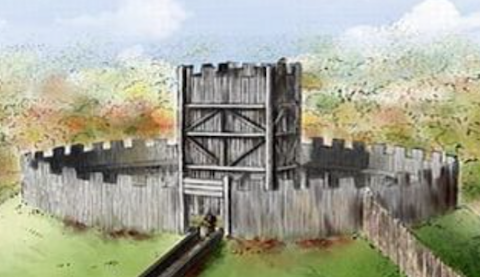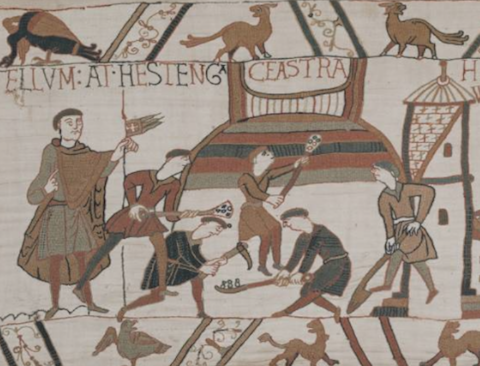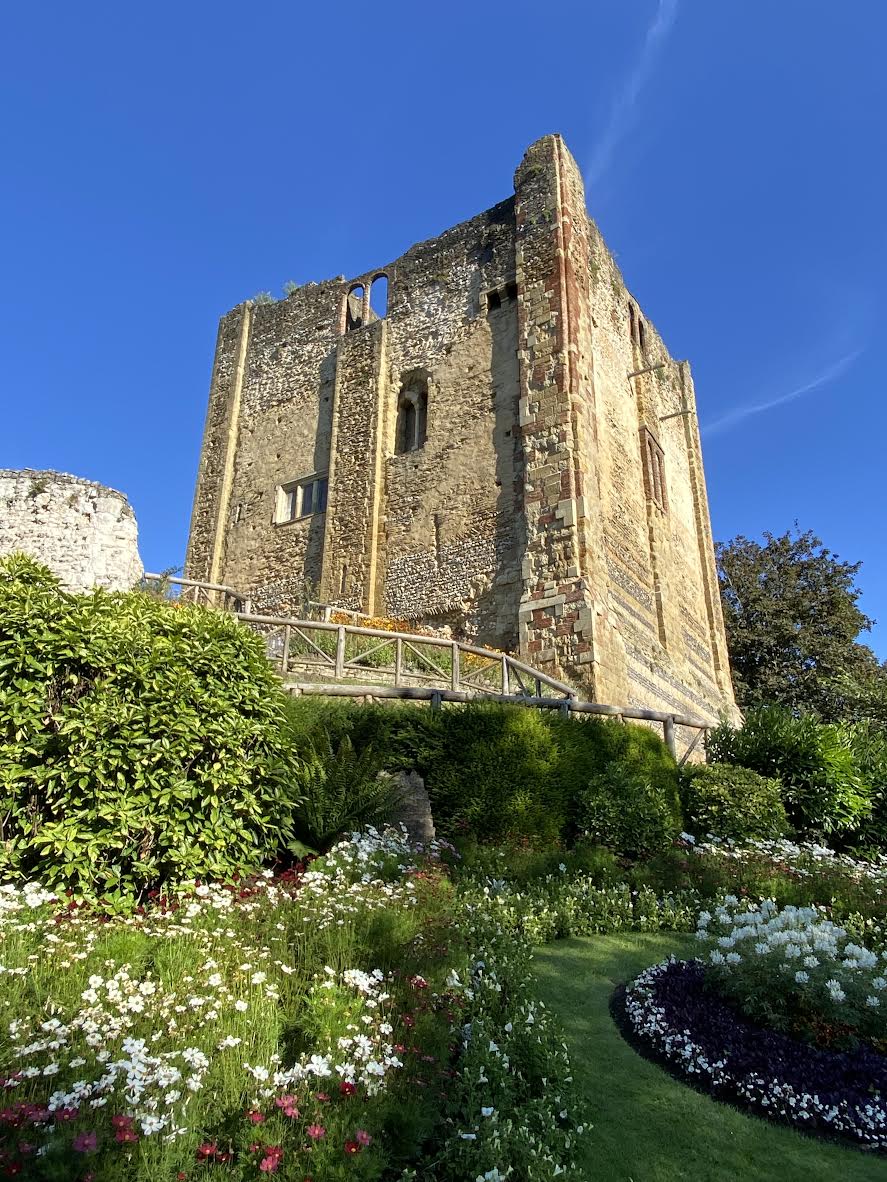 Abraham Lincoln
If given the truth, the people can be depended upon to meet any national crisis...
Abraham Lincoln
If given the truth, the people can be depended upon to meet any national crisis...
 Guildford news...
for Guildford people, brought to you by Guildford reporters - Guildford's own news service
Guildford news...
for Guildford people, brought to you by Guildford reporters - Guildford's own news service
Was the Original Guildford Castle a Flat-Packed Construction?
Published on: 13 Oct, 2024
Updated on: 16 Oct, 2024
Elliot Rowland takes a look at this idea, putting it together himself, so to speak…
The early history of Guildford Castle is shrouded in mystery, with few records of its existence appearing until the late 12th century.
One obscure mention in the Domesday Book describes a “site” held by the Norman sheriff Ranulf, possibly an early castle.
Crucially, we do not have a precise foundation date for Guildford Castle, although it is extremely likely that the site was being used as a defensive location from 1066 onwards. When a local anonymous guidebook author in 1887 described information on Guildford Castle’s early history as “meagre and conjectural”, it’s hard not to agree.

Could the original castle at Guildford have looked something like this?
The Normans are recognised for bringing the motte-and-bailey model of military fortification to England’s shores. Given that two-thirds of all Norman castles across Britain began as this design, it is likely that pre-stone Guildford Castle was one of these.
However, there is another form of castle that the Normans brought with them during the Invasion of 1066, potentially one that the Normans constructed in Guildford during the Conquest of England.
The Normans prepared long and hard for their invasion of England, setting sail from France with a fleet of hundreds of ships containing enough soldiers, craftsmen and provisions to conquer a nation.
Upon landing at Pevensey in September 1066, the Norman carpenters unpacked a very interesting set of supplies, described by medieval chronicler Wace thus: “Then they cast out of the ships the materials, and drew them to land, all shaped framed and pierced to receive the pins which they had brought, cut and ready in large barrels; so that before evening had well set in, they had finished a fort.”
It seems the Normans brought with them a series of prefabricated wooden parts, metal bolts and fittings designed to be assembled into defensible structures – flat-packed castles!

The Bayeux Tapestry gives clues to the Normans’ construction of fortifications.
Depicted in the Bayeux Tapestry, these were designed to be erected quickly and easily, allowing for the rapid consolidation of conquered land.
They weren’t substantial, they were mere kits containing enough material for a basic stilted platform, tower or square donjon (keep). It’s not unrealistic to theorise that kit-castles might have been built at locations outside of those recorded at Pevensey, Berkhamsted and Hastings. Norman-conquered Guildford might have been one such location.
I must stress that this is just a theory of mine. This article is designed to explore the reasons that why the Normans might have constructed a flat-packed castle in Guildford during 1066, and to outline some reasons why it made contextual sense.
I’d love to claim that the construction of a Guildford kit-castle in 1066 is a solid argument reinforced by historical evidence and archaeological proof. However, akin to my experience with flat-packed Ikea furniture, the setup takes too long, and the final product is wobbly!
A flat-packed Guildford Castle would have allowed the Normans the ability to tap into and control Guildford’s wealth, at a crucial juncture in the Conquest. The Domesday Book records Guildford’s income at 18 pounds and 2 pence in 1066, a tidy sum for a Norman Duke that had taken on considerable debt to muster his army.
It was unlikely the Normans would have been able to maintain control over Guildford’s recorded population of 175 households, one of the largest 20% of settlements in Domesday.
Garrisoning Guildford would have required considerable manpower that the Normans could not spare. A kit-castle’s fast deployment would have acted as a force-multiplier against rebellious Anglo-Saxons, and a secure tax office and treasury for Norman nobles to directly benefit from.
Leaving Guildford without a suitable location for garrison defence would have been at the detriment of Norman financial motivations.
Placing a flat-packed castle at the foot of Pewley Hill would have granted Norman control over the Wey Gap, a small channel within the North Downs through which the River Wey flows.
This was not only for commercial reasons, but military ones.
At the time of Guildford’s capture (likely between October-November 1066), the Normans were circling London, in part to lure the Anglo-Saxon army to battle.
By building a kit-castle at Guildford, the Normans could potentially pin down an Anglo-Saxon army trying to recapture the settlement, before the main Norman army arrived to destroy them – a common medieval military tactic.
By establishing a Norman defensive structure in the Wey Gap, any Anglo-Saxon army would have been funnelled into a small stretch of marshy ground either side of the river, hardly suitable ground for a defensive battle.
To circumvent Guildford, an enemy army would have had to make their way over Pewley Hill or the Hog’s Back, a tough prospect given the considerable weight of armour, arms and supplies.
A flat-packed Guildford Castle would have also served as a crucial base of operations and logistics.
One of the main recorded functions of flat-packed castles was as a supply depot, which stored Norman provisions during the Battle of Hastings.
A garrison could secure regions of Surrey in proximity to Guildford, capturing other settlements, suppressing rebellions and defending the supply chain from the coast.
Additionally, the Normans would not have had to spend unnecessary manpower guarding vulnerable Anglo-Saxon granaries in Guildford.
By transferring stocks of food and potable water to the kit-castle, they could extort control over Guildford’s population, rapidly cementing early Norman rule.
As mentioned, the evidence for a flat-packed castle at Guildford in 1066 is non-existent. There are no contemporaneous sources that support the hypothesis, and any archaeological evidence has likely vanished.
But a 1066-era kit-castle at Guildford would have granted the Normans considerable benefits to controlling the land and peoples of Surrey.
It would have saved crucial manpower, resources and time when these were at a premium, and while covering their rearward flanks.
It would have shocked or over-awed a potentially rebellious population and served as a simple and quickly constructed nucleus to future Norman military fortification. In several ways, it makes sense.
Responses to Was the Original Guildford Castle a Flat-Packed Construction?
Leave a Comment Cancel replyPlease see our comments policy. All comments are moderated and may take time to appear. Full names, or at least initial and surname, must be given.
Recent Articles
- Hero’s Welcome for Baden-Powell Returning from the South African War
- MP Hunt Presses Government Over Ash Vale Station’s Access Problems
- Updated: Death of Man Found in Bellfields ‘Unexplained’, Say Police
- Events Celebrating 150th Anniversary of St Nicolas Parish Church
- Letter: Would a Guildford Town Council Simply Be a GBC Version 2.0?
- Approval for Family Home To Be Converted into ‘House in Multiple Occupation’
- The Yvonne Arnaud Theatre Is a Lucrative Asset for Guildford’s Economy
- Notice: Community Safety Meeting
- Letter: All Significant Decisions Will Be Taken by the New West Surrey Council in Future
- Letter: What is the Evidence for the Lib Dem’s Sweeping Statement?



Recent Comments
- Kevin Rye on Borough Council Launches Second Stage of Town Council Consultation
- Olly Azad on Family Pays Tribute to James, 21, Following New Year’s Day Tragedy
- David Roberts on Borough Council Launches Second Stage of Town Council Consultation
- A Windebank on An ‘Outstanding’ GP Surgery
- Frank Emery on ‘We’ll Make Sure Guildford’s Voice Is Heard’ Says Council Leader
- Jane Hill on ‘We’ll Make Sure Guildford’s Voice Is Heard’ Says Council Leader
Search in Site
Media Gallery
Cllr Townsend on Waverley’s CIL Issue
August 27, 2025 / Comments Off on Cllr Townsend on Waverley’s CIL Issue / Read MoreMP Zöe Franklin Reviews Topical Issues
August 27, 2025 / Comments Off on MP Zöe Franklin Reviews Topical Issues / Read MoreMP Hopes Thames Water Fine Will Be ‘Final Nail in Its Coffin’
August 27, 2025 / Comments Off on MP Hopes Thames Water Fine Will Be ‘Final Nail in Its Coffin’ / Read MoreNew Guildford Mayor Howard Smith
August 27, 2025 / Comments Off on New Guildford Mayor Howard Smith / Read MoreA New Scene for a Guildford Street
August 27, 2025 / Comments Off on A New Scene for a Guildford Street / Read MoreDragon Interview: Sir Jeremy Hunt MP on His Knighthood and Some Local Issues
August 27, 2025 / Comments Off on Dragon Interview: Sir Jeremy Hunt MP on His Knighthood and Some Local Issues / Read MoreDragon Interview: Paul Follows Admits He Should Not Have Used the Word ‘Skewed’
August 27, 2025 / Comments Off on Dragon Interview: Paul Follows Admits He Should Not Have Used the Word ‘Skewed’ / Read MoreDragon Interview: Will Forster MP On His Recent Visit to Ukraine
August 27, 2025 / No Comment / Read MoreDragon Interview: Fiona Davidson on the ‘Devolution’ Proposals for Surrey
August 27, 2025 / No Comment / Read More









Aubrey Leahy
October 15, 2024 at 9:14 am
Interesting theory and well within the realm of probability.
No doubt The Normans would’ve managed to house three times the population of Guildford in a project similar to the North Street one by Christmas of 1067. Maybe after finishing the Debenhams site a few months earlier at Michaelmas?
“Those who forget the lessons of history…”
Elliot Rowland
October 29, 2024 at 3:42 pm
Thanks to Aubrey Leahy for the feedback. Indeed, I think the Normans would have had access to the materials and capabilities needed for such a construction, or even a network of Norman bases around England. However, hard to impossible for us to find any evidence for this.
Very interesting regarding the North Street and Debenhams references, what do you mean by this? Are these sites of Anglo-Saxon fortifications or perhaps the Burgh walls?